
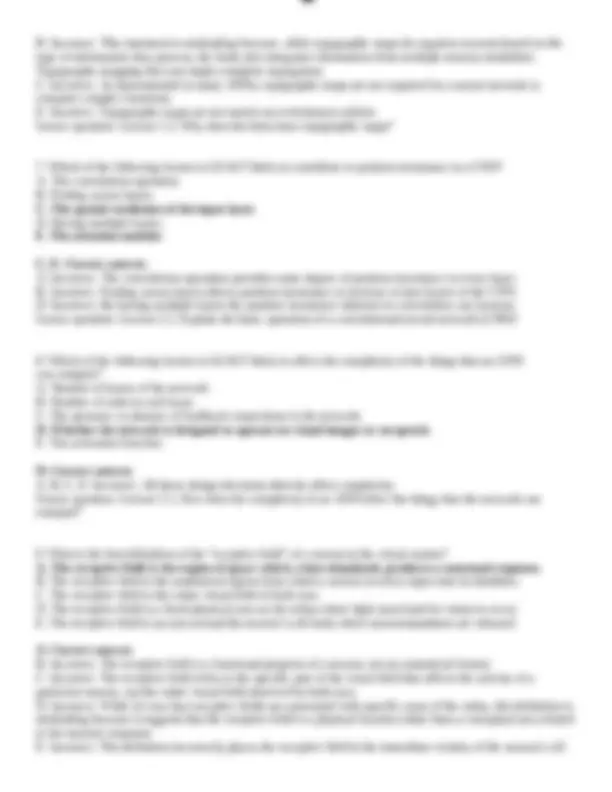
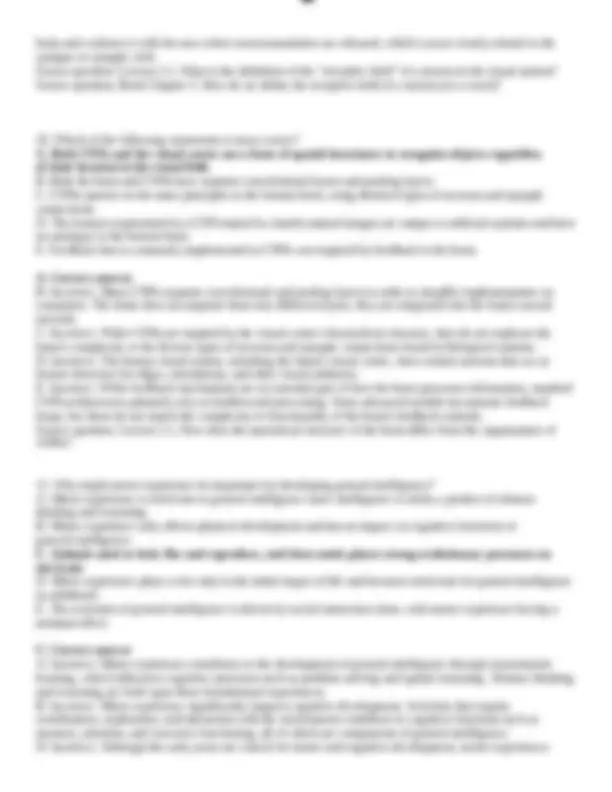
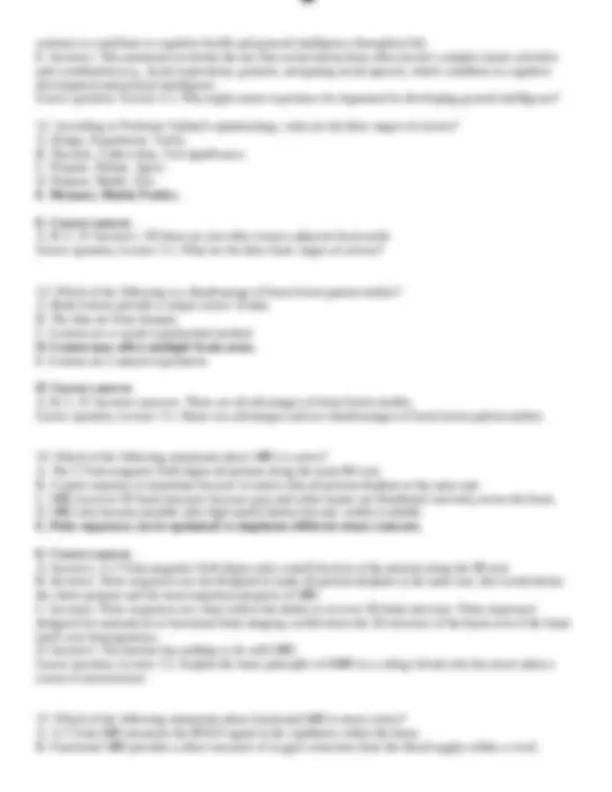
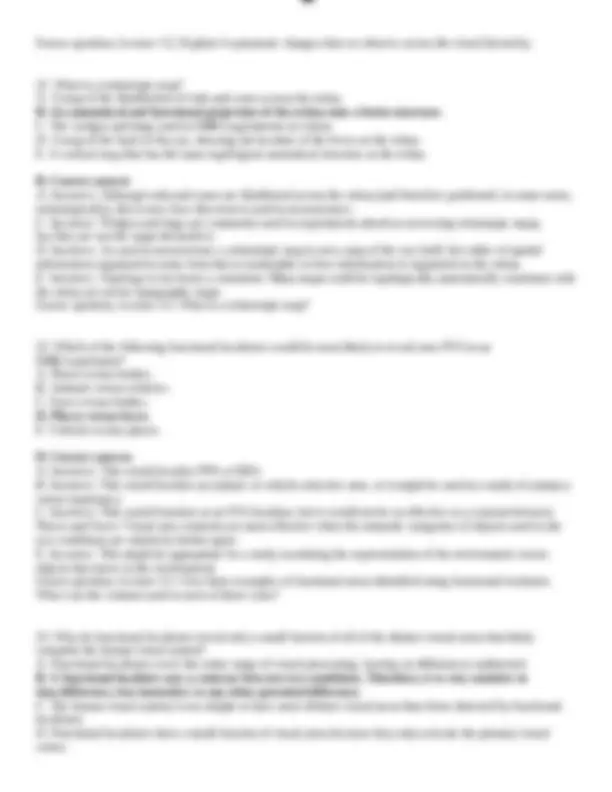
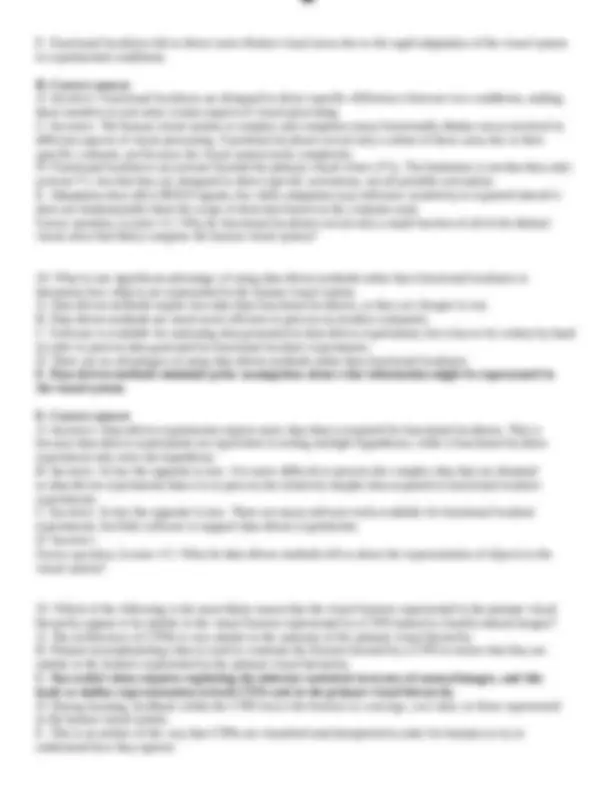
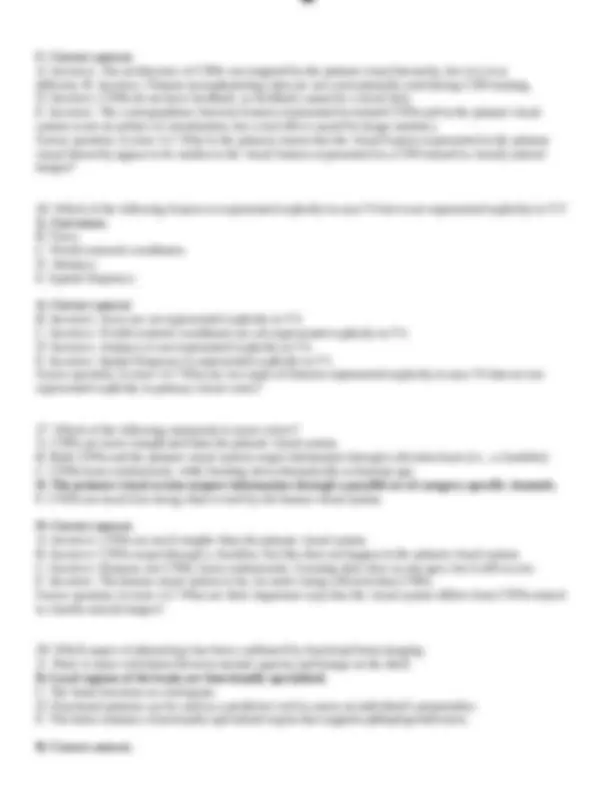
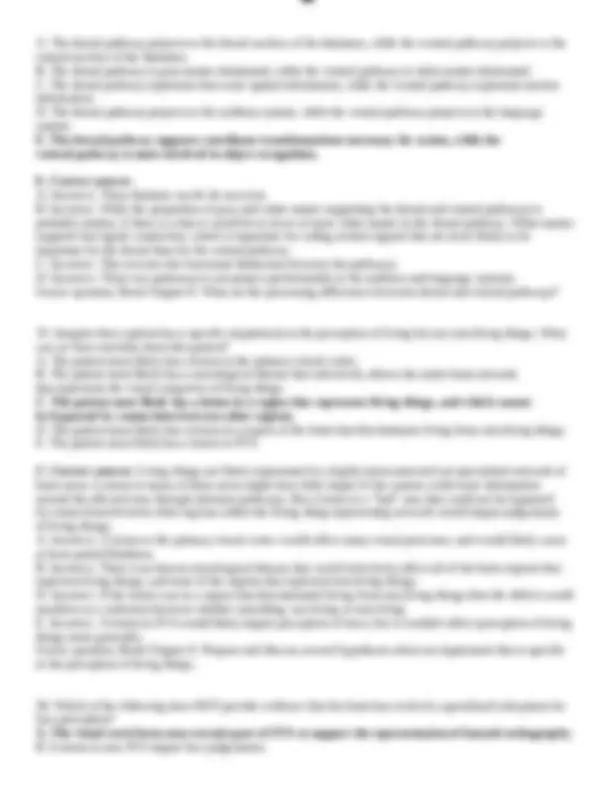




Study with the several resources on Docsity

Earn points by helping other students or get them with a premium plan


Prepare for your exams
Study with the several resources on Docsity

Earn points to download
Earn points by helping other students or get them with a premium plan
Community
Ask the community for help and clear up your study doubts
Discover the best universities in your country according to Docsity users
Free resources
Download our free guides on studying techniques, anxiety management strategies, and thesis advice from Docsity tutors
PSYCH/COGSCI 127, COGNITIVE NEUROSCIENCE, SPRING 2024 ANSWER KEY FOR MIDTERM 1 VERSION A (14 FEB 2024)
Typology: Exams
1 / 15

This page cannot be seen from the preview
Don't miss anything!










NOTE: All exams contained the same questions, but they were shuffled across exams. So the order of the questions on this answer sheet is likely NOT consistent with the order on your exam.
transmission is chemical, not electrical. C: Incorrect. This statement is incorrect because action potentials are typically initiated in the axon hillock, a specialized region of the neuron near the junction of the axon and the cell body. D: Incorrect. This statement is incorrect because neurotransmitters can be either excitatory or inhibitory, depending on their type and the receptors they bind to on the postsynaptic neuron. Source question: Lecture 1.2, How does a neuron transform a signal from input to output (explain entire process)?
body and confuses it with the area where neurotransmitters are released, which is more closely related to the synapse or synaptic cleft. Source question: Lecture 2.1, What is the definition of the "receptive field" of a neuron in the visual system? Source question, Book Chapter 5: How do we define the receptive field of a neuron (or a voxel)?
continue to contribute to cognitive health and general intelligence throughout life. E: Incorrect. This statement overlooks the fact that social interactions often involve complex motor activities and coordination (e.g., facial expressions, gestures, navigating social spaces), which contribute to cognitive development and general intelligence. Source question: Lecture 2.1, Why might motor experience be important for developing general intelligence?
C. Because the peripheral visual field is so much larger than the fovea, the peripheral regions of the visual field are represented by a larger area on the visual cortex than the central regions. D. The left eye projects to the right occipital lobe, and the right eye projects to the left occipital lobe. E. Because light reflects off of the back of the eye before being transduced by the photoreceptors, the retinotopic map on primary visual cortex is flipped left-right, but not up-down. A: Correct B: Incorrect. This statement is incorrect because the mapping is not uniform; the foveal region of the visual field is overrepresented compared to the peripheral regions, reflecting the fovea's higher density of photoreceptor cells and its importance for high-resolution vision. C: Incorrect. This is the opposite of the actual organization; the central regions of the visual field (near the fovea) occupy a relatively larger portion of the visual cortex. D: Incorrect. The left visual field of both eyes projects to the right occipital lobe, and the right visual field of both eyes projects to the left occipital lobe. E: Incorrect. The eye functions as a lensed system, not a mirror. Thus, light is flipped both left-right and up-down. Source question, Lecture 3.2, How is the visual field mapped onto the cerebral cortex?
Source question, Lecture 3.2, Explain 4 systematic changes that we observe across the visual hierarchy.
C: Correct answer. A: Incorrect. The architecture of CNNs was inspired by the primate visual hierarchy, but it is very different. B: Incorrect. Primate neurophysiology data are not conventionally used during CNN training. D. Incorrect. CNNs do not have feedback, so feedback cannot be a factor here. E. Incorrect. The correspondence between features represented in trained CNNs and in the primate visual system is not an artifact of visualization, but a real effect caused by image statistics. Source question, Lecture 4.2: What is the primary reason that the visual features represented in the primate visual hierarchy appear to be similar to the visual features represented in a CNN trained to classify natural images?
A: Incorrect. There is no correlation between the pattern of bumps on the skull and underlying brain function. C: Incorrect. The holographic brain was not posed by the phrenologists, but by a competing faction of scientists working around the same time in the 19th century. D: Incorrect. The phrenologists thought that their science could be used as a predictive tool to assess an individual's propensities and as a diagnostic tool to identify imbalances or deficiencies in character. This was used in various contexts, including education, mental health, and even in attempts to reform criminals. Modern brain imaging has not shown that this is true other than in some extremely limited and narrow circumstances. E: Incorrect. Philoprogenitiveness is related to the love and care of one's offspring. The human brain includes many functionally specialized areas that represent information about social relationships, but no one has yet reported one specific area that supports this specific aspect of social behavior. Source question, Book Chapter 1: Will brain imaging experiments become the new phrenology?
A. The dorsal pathway projects to the dorsal nucleus of the thalamus, while the ventral pathway projects to the ventral nucleus of the thalamus. B. The dorsal pathway is gray-matter-dominated, while the ventral pathway is white-matter-dominated. C. The dorsal pathway represents fine-scale spatial information, while the ventral pathway represents motion information. D. The dorsal pathway projects to the auditory system, while the ventral pathway projects to the language system. E. The dorsal pathway supports coordinate transformations necessary for action, while the ventral pathway is more involved in object recognition. E: Correct answer. A: Incorrect. These thalamic nuclei do not exist. B: Incorrect. While the proportion of gray and white matter supporting the dorsal and ventral pathways is probably similar, if there is a bias it would be in favor of more white matter in the dorsal pathway. White matter supports fast signal conduction, which is important for coding motion signals that are more likely to be important for the dorsal than for the ventral pathway. C: Incorrect. This reverses the functional distinction between the pathways. D: Incorrect. These two pathways to not project preferentially to the auditory and language systems. Source question, Book Chapter 6: What are the processing differences between dorsal and ventral pathways?
C. Many people suffer from prospagnosia. D. Several different face-selective patches have been reported in the primate visual system. E. Neurons in FFA give much larger responses to pictures of faces than to pictures of any other objects. A: Correct answer. The existence of the VWFA does not provide evidence either for or against a specialized face processing system. B, C, D, E: Incorrect. All these lines of evidence provide support for the existence of a specialized face processing system. Source question, Book Chapter 6: Summarize the evidence that the brain has evolved a specialized subsystem for face perception.